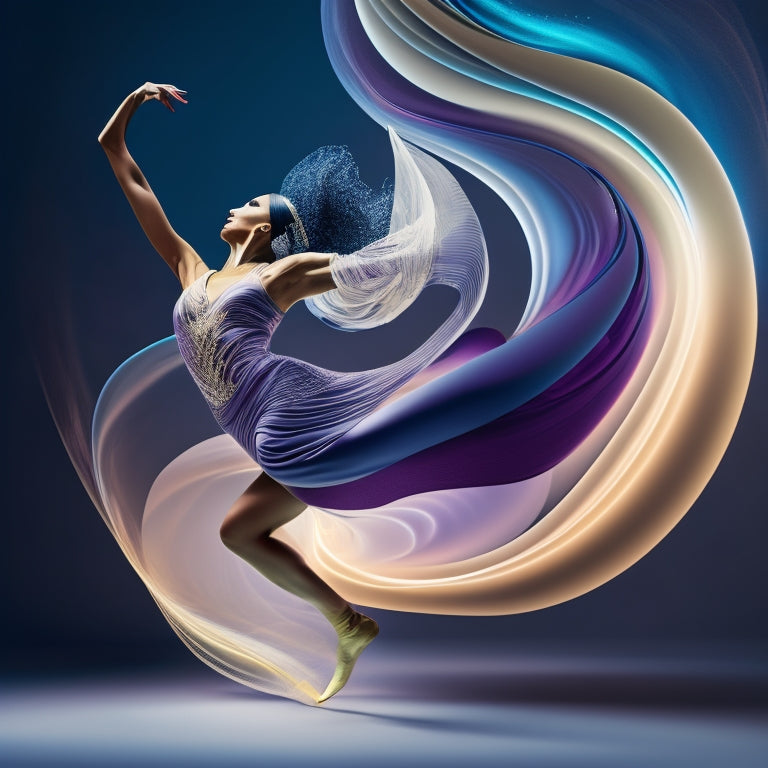
Why Do Flexibility Drills Matter in Dance Training?
Share
When you incorporate flexibility drills into your dance training, you're not only improving your range of motion, but also building strength, perfecting technique, and unleashing your full artistic expression. Flexibility exercises enhance posture, alignment, and muscle memory, making mastering dance techniques easier. By prioritizing flexibility, you'll reduce injury risk, improve control, balance, and coordination, and develop a deeper kinesthetic connection. As you explore the world of flexibility drills, you'll discover how targeted exercises can isolate specific muscle groups, leading to seamless movements and enhanced articulation. You're just getting started on a journey to unleashing your full potential.
Key Takeaways
• Flexibility drills enhance technique and performance by building strength and reducing muscle tension, leading to improved overall dance quality.
• Prioritizing flexibility exercises improves posture, alignment, and technique, reducing the risk of injury and enhancing overall dance ability.
• Enhanced flexibility allows for greater range of motion, making it easier to master complex dance techniques and achieve fluid movements.
• Flexibility drills develop heightened body awareness, reducing injury risk and improving control, balance, and coordination in dance movements.
• Regular flexibility practice helps mitigate age-related decline in flexibility, ensuring dancers can maintain their skills and abilities over time.
Building Strength Through Flexibility
As you explore the world of dance training, it's important to acknowledge that developing strength through flexibility is a key aspect of enhancing your overall technique and performance.
Flexibility is often misunderstood as simply being able to touch your toes or perform a split. However, it's crucial to understand that flexibility is closely tied to strength, and building strength through flexibility is necessary for excellent performance.
When you incorporate mindful stretching into your routine, you're not only increasing your range of motion but also strengthening the muscles surrounding your joints. This, in turn, enhances your overall stability and control.
Active recovery techniques, such as foam rolling and self-myofascial release, can also aid in reducing muscle tension and improving flexibility. By prioritizing flexibility exercises, you'll notice improvements in your posture, alignment, and overall dance technique.
Preventing Injury With Proper Technique
By incorporating flexibility exercises into your dance training, you're not only building strength and control but also laying the foundation for proper technique, which is critical in preventing injuries that can sideline your performance.
When you focus on flexibility drills, you're better equipped to maintain safe alignment, reducing your injury risk. This is particularly important in dance, where improper alignment can put unnecessary stress on your joints and muscles, leading to strains, sprains, and even long-term damage.
Unlocking Range of Motion Potential
As you concentrate on maximizing your range of motion potential, you'll want to prioritize exercises that improve joint mobility, allowing for seamless shifts and more fluid movements.
By enhancing muscle elasticity, you'll also enhance your overall flexibility, making it easier to master complex dance techniques.
Enhance Joint Mobility
To release your full range of motion potential, you must focus on exercises that target specific joints, increasing flexibility and reducing stiffness in areas like the hips, knees, and ankles. By doing so, you'll be able to move with greater ease and fluidity, which is essential for dancers.
Dynamic stretching exercises, such as leg swings and arm circles, are particularly effective in enhancing joint mobility. As you age, it's natural for your joints to lose flexibility, but with regular practice, you can maintain or even improve your range of motion. Age-related decline in flexibility doesn't have to limit your movement.
Increase Muscle Elasticity
How can you access your full range of motion potential without increasing muscle elasticity, the ability of your muscles to lengthen and shorten in response to movement? By incorporating flexibility drills into your dance training, you can unleash your range of motion potential and improve overall performance.
When you stretch, your muscles undergo a process called muscle rebound, where they lengthen and then rebound back to their original state. However, if you don't push past your elastic limits, you won't achieve significant gains in flexibility.
It's important to challenge your muscles to lengthen beyond their comfortable range, allowing them to adapt and increase their elasticity. As you consistently push past your elastic limits, your muscles will learn to lengthen and shorten more efficiently, enabling you to move with greater ease and control.
Improve Postural Awareness
You'll find that developing postural awareness is essential to accessing your full range of motion potential, as it enables you to maintain ideal alignment and engage the correct muscles to execute movements with precision and control. By cultivating postural awareness, you'll be able to optimize your body's alignment, reducing the risk of injury and enhancing overall performance.
Through mindful alignment and body mapping, you can develop a deeper understanding of your body's spatial relationships, allowing you to:
- Identify and correct imbalances in your posture
- Engage the correct muscles to support your movements
- Increase your overall range of motion and flexibility
Enhanced Body Awareness Through Drills
By incorporating targeted flexibility drills into your dance training, you develop a heightened sense of body awareness, allowing for more precise control over your movements. This increased awareness enables you to better understand your physical limitations and capabilities, reducing the risk of injury and improving overall performance.
Through mindful exploration of your body's range of motion, you'll cultivate a deeper kinesthetic connection, allowing you to intuitively sense the subtle changes in your body's alignment and movement patterns. As you practice flexibility drills, you'll become more attuned to the subtle nuances of your body, refining your ability to execute complex movements with precision and control.
Mastering Isolations With Flexibility Exercises
As you incorporate targeted flexibility exercises into your dance training, you're able to isolate specific muscle groups, refining your control over precise movements and subtle articulations. This mastery of isolations is essential for executing complex dance movements with precision and control.
By focusing on specific areas of the body, you can develop the strength, flexibility, and coordination required for advanced techniques.
Through flexibility exercises, you can:
- Enhance articulation techniques, allowing for more nuanced and expressive movements
- Develop dynamic expression, adding depth and emotion to your performances
- Improve overall control and coordination, reducing the risk of injury and enhancing overall performance quality
Improving Posture and Alignment
As you focus on improving your posture and alignment, you'll want to prioritize core engagement, correcting muscle imbalances that can throw your entire body out of whack.
By doing so, you'll establish a strong foundation for ideal spinal alignment, which is essential for efficient movement and injury prevention.
Core Engagement Matters
Your core muscles, comprising the transverse abdominis, obliques, and lower back, play an essential role in maintaining ideal posture and alignment, as they provide the foundation for efficient movement and prevent unnecessary strain on your joints. When your core is engaged, you'll experience improved balance, stability, and overall control.
This, in turn, enables you to execute dance movements with greater precision and confidence.
To achieve ideal core engagement, focus on the following key elements:
-
Breath Control: Develop a conscious awareness of your breath, allowing you to maintain a consistent, relaxed state. This helps you access your core muscles more efficiently.
-
Pelvic Tilt: Engage your core by imagining a gentle tilt of your pelvis, which helps maintain a neutral spine and promotes efficient energy transfer.
-
Core Activation: Consciously engage your transverse abdominis by drawing your belly button towards your spine, creating a sense of stability and support.
Muscle Imbalance Correction
By recognizing and addressing muscle imbalances, you can correct postural deviations, alleviate undue stress on your joints, and ultimately refine your overall dance technique. Muscle imbalances occur when some muscles become overactive, while others remain underactive, disrupting your body's natural alignment. This can lead to poor posture, inefficient movement patterns, and increased risk of injury.
To identify muscle imbalances, it's crucial to undergo a thorough posture analysis. This involves evaluating your overall posture, including the alignment of your head, shoulders, spine, hips, knees, and ankles. Muscle testing can also help identify specific muscle imbalances.
For instance, testing your shoulder range of motion can reveal if your pectoral muscles are overactive, causing your shoulders to roll forward.
Spinal Alignment Essentials
Properly aligning your spine is crucial for maintaining ideal posture, as even slight deviations can throw your entire body out of balance and compromise your dance technique. When your spine is aligned, you'll experience improved flexibility, reduced muscle strain, and enhanced overall performance.
To achieve the best spinal alignment, focus on the following key elements:
-
Pelvic Awareness: Engage your core muscles to stabilize your pelvis, ensuring it remains neutral and stable. This will help maintain a healthy curvature of your lower back.
-
Breathing Techniques: Practice diaphragmatic breathing to expand your chest cavity, allowing your spine to elongate and relax. This will help reduce tension and promote a more upright posture.
-
Shoulder Relaxation: Release any tension in your shoulders, allowing them to relax down and away from your ears. This will help open up your chest and improve your overall posture.
Reducing Muscle Tension and Stress
As you explore flexibility exercises, keep in mind that relaxed muscles are more receptive to lengthening, which is why reducing muscle tension and stress is essential for peak dance performance.
When you're tense, your muscles are less responsive to stretching, making it harder to achieve best flexibility. To combat this, prioritize mental relaxation techniques, such as visualization and meditation, to calm your mind and release physical tension.
Breathing exercises are also vital, as deep, controlled breaths can help slow down your heart rate and relax your muscles. Try inhaling for a count of four, holding for a count of four, and exhaling for a count of four. This rhythmic breathing pattern can help calm your nervous system and reduce muscle tension.
Achieving Fluidity in Dance Movements
To execute dance movements with fluidity, you need to focus on connecting individual steps into seamless progressions, allowing your body to flow effortlessly from one pose to the next. This is where flexibility drills come into play, helping you develop the range of motion and control necessary for fluid movements.
By incorporating flexibility exercises into your dance training, you'll be able to:
-
Improve your dance phrasing by moving smoothly from one step to the next, creating a more cohesive and polished performance
-
Enhance your musicality exploration by responding to the rhythm and melody with ease and precision
-
Increase your overall control and balance, reducing the risk of injury and improving your overall dance technique
As you work on achieving fluidity in your dance movements, remember that it's all about connection and flow. By focusing on seamless progressions and controlled movements, you'll be able to take your dancing to the next level and deliver a captivating performance.
Developing Muscle Memory Through Repetition
By repeating specific dance movements and exercises, you build muscle memory, allowing your body to internalize the necessary techniques and execute them with increased precision and efficiency. Through repetition, you develop Muscle Mastery, where your body learns to perform complex movements with ease and accuracy. This is essential in dance training, as it enables you to focus on expression, musicality, and artistry, rather than struggling with technique.
Repetition Rewards you with improved control, balance, and coordination, allowing you to tackle challenging choreography with confidence. As you repeat exercises and movements, your body adapts and adjusts, refining your technique and reducing the risk of injury. With each repetition, your muscle memory grows stronger, freeing your mind to focus on the artistic aspects of dance.
Frequently Asked Questions
Can Flexibility Drills Be Adapted for Dancers With Physical Limitations?
You can adapt flexibility drills for dancers with physical limitations by incorporating modified routines and accessible stretching exercises, ensuring a safe and inclusive environment that caters to individual needs and abilities.
How Often Should I Incorporate Flexibility Exercises Into My Dance Practice?
To optimize your flexibility gains, you should incorporate exercises into your daily routine 2-3 times a week, aligning with your practice schedule and workout frequency, to achieve your flexibility goals within a specific training cycle.
Will Focusing on Flexibility Compromise My Strength and Power?
Ironically, you're worried that flexibility will compromise strength, but neglecting flexibility can lead to muscle imbalance, making you more prone to injury. Focusing on flexibility drills can actually improve overall power and reduce overstretching risks, making you a stronger, safer dancer.
Can Flexibility Exercises Help With Anxiety and Performance Nerves?
When you practice flexibility exercises, you'll find that incorporating breathing techniques and mindfulness practices can help calm your nerves, reducing anxiety and performance anxiety, allowing you to feel more centered and focused on stage.
Are Flexibility Drills Beneficial for Dancers of All Ages and Styles?
'As you begin your dance journey, flexibility drills become a golden thread, weaving together age appropriateness, style versatility, and dance longevity, while preventing injuries and enhancing technique - a safety net for dancers of all ages and styles.'
Related Posts
-

Benefits of Wearing Activity Trackers Daily
Wearing an activity tracker daily can transform your fitness routine. You'll gain understanding into your daily steps...
-

Tips and Tricks for Collapsible Ballet Bar Installation
To install your collapsible ballet bar, start by gathering essential tools like a drill, level, and measuring tape. M...
-

Unleash the Secrets of Shinobi: Genesis Manual
The Shinobi: Genesis Manual is a treasured resource for enthusiasts, offering an in-depth exploration into the intric...


